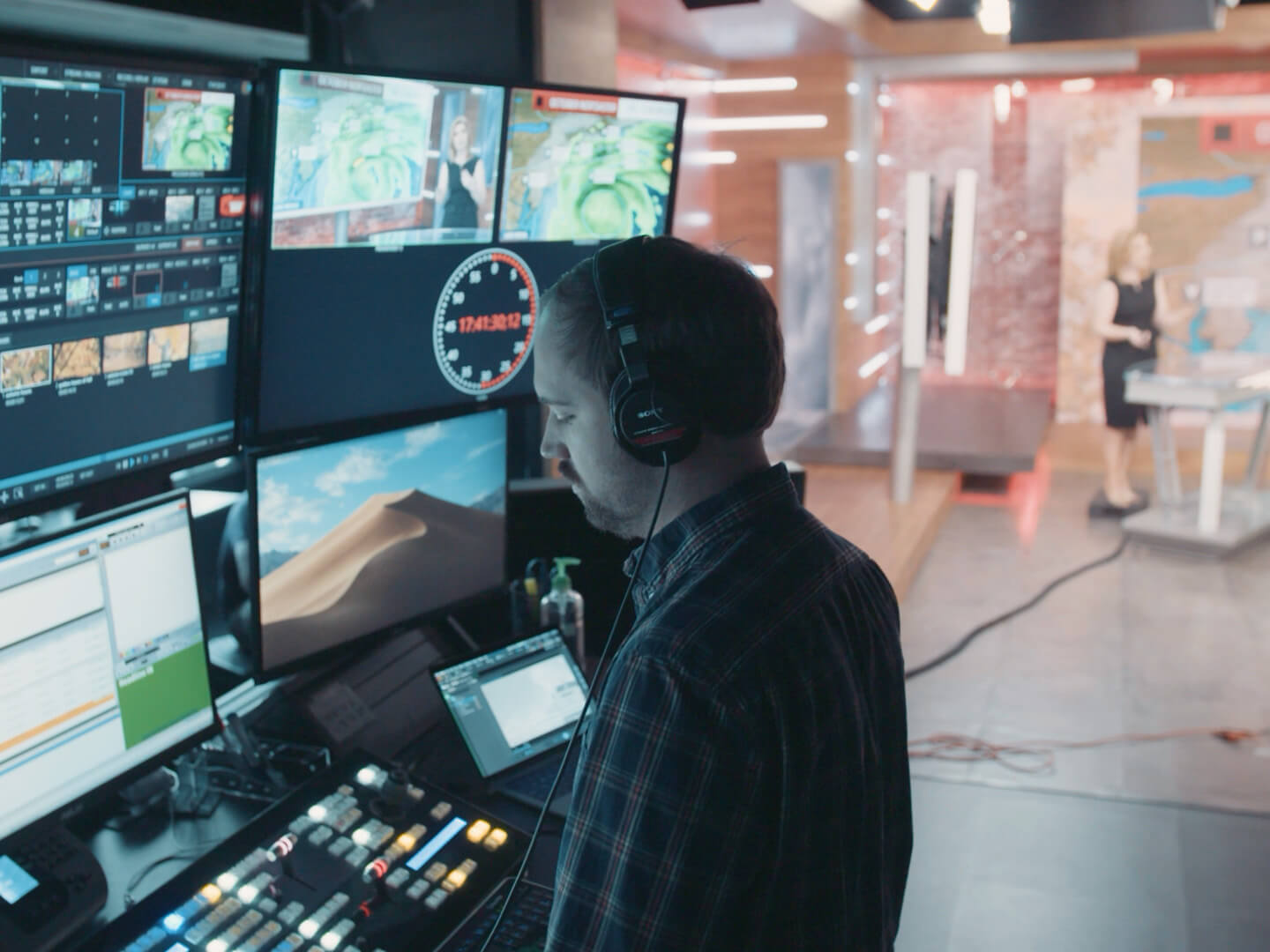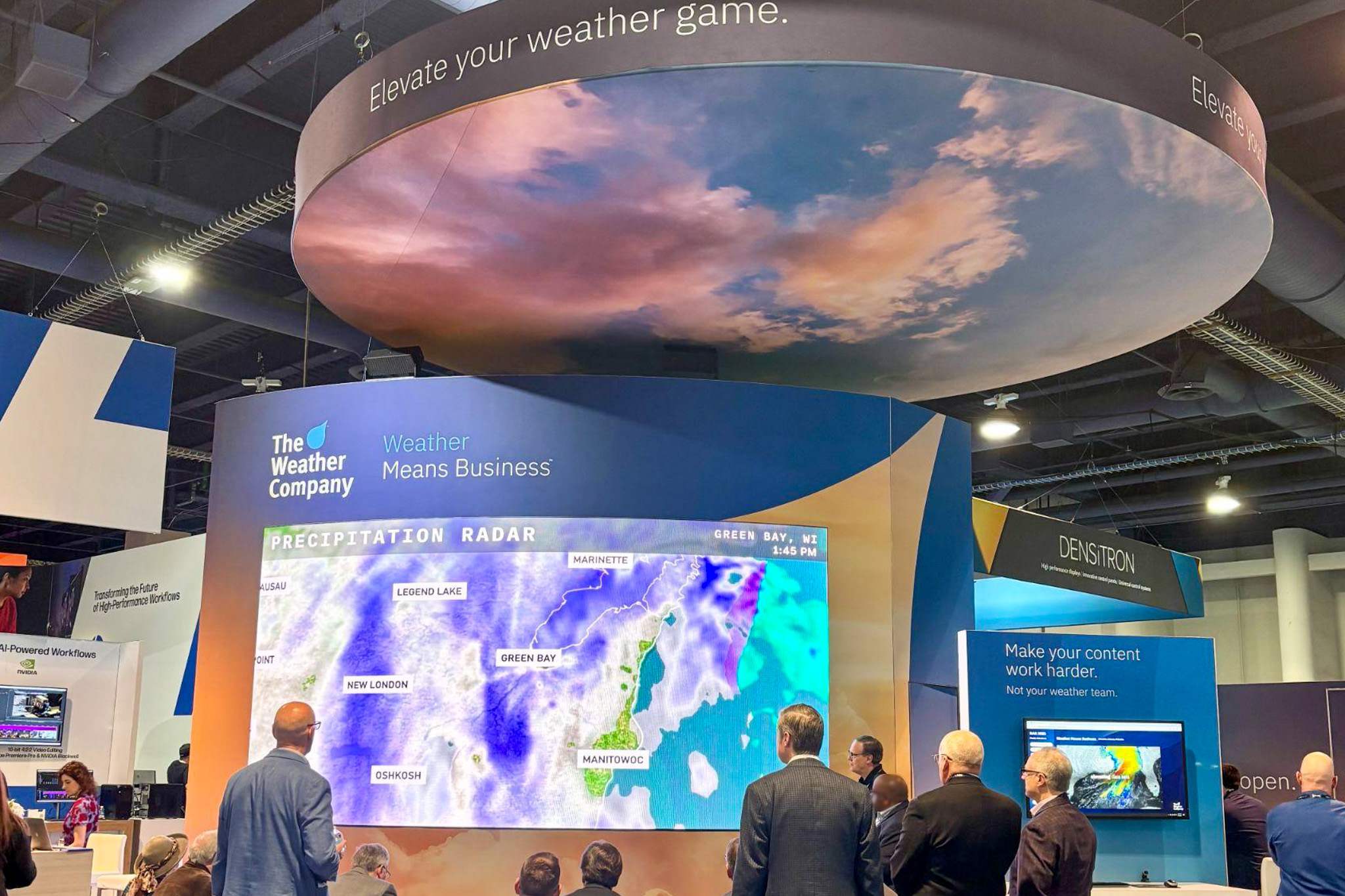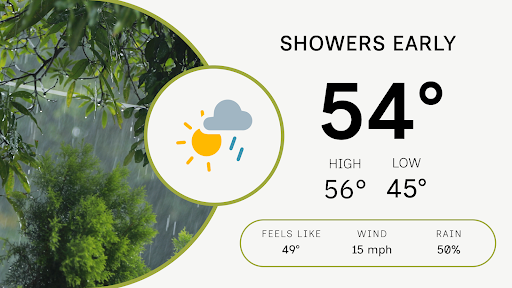Weather intelligence for the future: Crafting a strategic enterprise approach to changing environmental conditions
Continue readingIn today’s rapidly evolving media landscape, an efficient weather broadcast workflow is incredibly important. Whether you broadcast on television, radio or online, optimizing your workflow can lead to better content and increased audience engagement. In this article, we explore the concept of a broadcast workflow, its importance and provide six valuable tips to enhance it.
Let’s dive in and discover how to make your broadcasting process more efficient.
What is a broadcast workflow?
In the realm of weather forecasting, a broadcast workflow serves as a structured method for crafting and disseminating content, primarily tailored for television. This specialized workflow combines elements such as audio, video production, graphics and storytelling to weave together compelling narratives about important news stories such as weather conditions and forecasts.
Audio, video and graphics each play an integral role in this content. Audio components like spoken weather updates, meteorological explanations and ambient sounds can all enhance the viewer’s experience. Video takes center stage with live weather presenters, on-location footage, dynamic animations, real-time traffic updates and informative visuals that aid in conveying complex meteorological data. And finally, video storytelling weaves these elements into cohesive and impactful narratives, transforming raw weather information into compelling stories that resonate with viewers.
What are the types of weather broadcasting?
The world of broadcasting extends far beyond the confines of a single medium, encompassing a diverse range of practice areas, each with its unique challenges and opportunities. Weather broadcasting, in particular, stands out as a specialized domain that demands adaptability and innovation to engage and inform its audience effectively.
Here are just a few of the most common weather broadcasting practice areas:
Television
Television broadcasting remains a potent medium for delivering weather updates, news, entertainment and information to a broad and varied audience. With the advent of streaming technology and the transition to high-definition broadcasts, the quality of weather content has soared to new heights. In particular, weather broadcasting has undergone a significant transformation, aligning with the expectations of modern viewers who crave instantaneous weather information and insights.
Digital
The internet has transformed the way content is delivered, making it accessible to global audiences through websites, and mobile and social apps. Many meteorologists and other weather forecasters are already promoting their broadcasts across a variety of digital channels. Weather is an important component for station groups, who want to create more content while showing viewers stories they care about. According to Ashton Altieri of CBS4, weather plays a key role across his station group’s OTT streams and social channels.
The introduction of cloud-based platforms has further accelerated a station’s need for digital channels by offering unparalleled flexibility, enhanced collaboration and the ability to broadcast remotely. This technological shift has not only increased productivity but also empowered weather teams to tap into the best talent worldwide to tell compelling weather stories.
Radio
Radio broadcasting continues to be a popular medium, providing music, news, engaging talk shows and weather updates to a diverse and loyal audience. While radio may lack the visual components of television or digital broadcasting, it relies profoundly on audio content and skillful storytelling to engage listeners. In the realm of weather broadcasting, radio follows a similar workflow, delivering vital weather information in a format that captivates the imagination and keeps communities informed about weather conditions.
How does a broadcast workflow work?
All weather broadcasts are preceded by several stages of preparation, each of which must be handled correctly to ensure success. Weather broadcasters must seamlessly navigate these stages to meet the evolving demands of today’s viewers and maintain the high standards expected in the industry.
Planning
The planning stage is where crucial decisions are made, including the broadcast topic, duration, platform and timing. Broadcasters must select a weather topic that resonates with their viewers and listeners, considering audience interests and staying attuned to current meteorological events or trends. For example, according to Magid’s research conducted on behalf of The Weather Company in May 2022, 49% of weather consumers are very interested in hearing more health-related news. Additionally, they must carefully determine the broadcast’s duration, striking a balance between brevity for breaking weather updates and depth for comprehensive weather analysis.
Creation
During the creation phase of the weather broadcast workflow, a multifaceted process unfolds to craft compelling content. This phase involves the integration of audio, video, graphics, and storytelling, marking a fusion of creative expression, technical proficiency and collaborative teamwork. Audio production captures and manipulates sound elements relevant to the weather report, while video production focuses on visually conveying weather stories through filming, animations and graphics.
Editing
Editing serves as the bridge that skillfully merges all components of the weather broadcast. Editors play a critical role by meticulously examining and refining the raw materials, which include audio recordings, video footage, graphics and the narrative script. Their goal is to ensure that each element not only meets but surpasses quality standards. Editors then weave these elements together into a cohesive and compelling narrative package that captivates and informs the audience effectively.
Distribution
Once the weather content is created and polished, the next critical step in the broadcast workflow is distribution. This phase involves the strategic dissemination of content across various platforms. These platforms encompass traditional television broadcasts, online weather portals, and radio. The success of this distribution process relies on the implementation of effective strategies to ensure that weather updates reach their intended audience promptly and leave a meaningful impact.
What are the advantages of an efficient broadcast workflow?
Efficiency is at the core of a successful weather broadcast workflow. Without efficiency, broadcasters risk falling behind competitors and losing the trust of their audience, which ultimately prevents them from being successful.
Getting a broadcast out first
Speed is crucial in broadcasting. Being the first to provide essential information can boost ratings, demand from advertisers and revenue. Viewers expect up-to-date and reliable information alongside broadcasters who deliver this to gain a competitive edge.
A greater focus on accuracy in weather forecasting
Accurate weather forecasting is not only essential for keeping viewers informed but also for building trust and credibility. Broadcasters who provide precise weather forecasts establish themselves as reliable sources of information. Additionally, advertisers can better target their audiences based on upcoming weather conditions, enhancing their effectiveness.
Efficiency
Efficiency means reduced costs, faster content production and better resource utilization. Cloud-based production tools, such as Max Cloud, streamline video production, allowing teams to create content from anywhere, respond to breaking news quickly and collaborate effectively.
What are the current challenges of developing a broadcast workflow?
Developing an effective broadcast workflow comes with a unique set of challenges. One significant challenge is the initial hurdle of getting started. Selecting the right broadcast workflow software that aligns with your business objectives can be a daunting task. It’s crucial to find a solution that caters to the specific needs of your organization and content goals.
Another challenge lies in applying consistency across all projects. Maintaining a consistent approach to content creation can be difficult but is vital for establishing a strong brand identity and engaging your audience effectively. Overcoming this challenge often involves the establishment of clear guidelines and standards to ensure that each project aligns with your overarching objectives.
Six tips to improve the weather broadcast workflow
Now that you have a better understanding of the requirements of a broadcast workflow, let’s delve into six insightful tips that will empower you to elevate your broadcasting process. By incorporating these strategies, you can streamline your workflow, enhance the quality of your content and ensure your broadcasts are not only informative but also engaging:
1. Invest in automation
Automation plays a pivotal role in streamlining broadcast workflows, freeing up valuable time for the human-centric aspects of broadcasting. Everyday forecasting benefits significantly from automation, utilizing advanced algorithms to swiftly process meteorological data, resulting in highly accurate and up-to-date automated weather forecasts. This not only elevates the quality of weather reporting but also fosters deeper audience engagement by providing essential information promptly.
Automation can also help to send out push notifications and alerts for rapidly changing weather conditions. Severe weather alerts, automatically generated by the National Weather Service, are vital for viewer safety during extreme weather events. These alerts can take various forms, from compelling textual notifications to engaging graphics, and are designed to interrupt regular programming to convey critical, potentially life-saving information during severe weather. Automation in this context proves invaluable in rapidly disseminating vital updates to the public and helping to ensure their safety while enhancing the viewer experience.
2. Take advantage of the cloud
Cloud-based platforms offer broadcasters not only flexibility and collaboration but also the ability to work seamlessly from anywhere at any time. They enable the inclusion of subject matter experts at the click of a button, enhancing the depth and credibility of broadcasts. Monetizing content becomes effortless, with customizable video themes that seamlessly incorporate partner branding and messaging, ultimately increasing revenue streams. With more content, there are more opportunities to monetize. In addition to these benefits, cloud-based production tools reduce costs significantly, making high-quality video production accessible without the need for extensive equipment and production teams.
3. Incorporate AI into the broadcast workflow
AI technologies are transforming the broadcasting landscape by enhancing the accuracy of weather predictions, ensuring that viewers receive precise and timely information. Through content triggers such as responding to changes in temperature or humidity, AI personalizes the user experience by delivering tailored content based on individual preferences and location, increasing audience engagement and satisfaction. Automated severe weather alerts powered by AI play a vital role in keeping viewers safe by delivering real-time notifications of impending weather hazards.
Moreover, AI weather forecasting enriches broadcasts with lifestyle context, offering viewers additional information on topics such as air quality indexes, pollen forecasts, and UV index levels, further enhancing their decision-making based on weather conditions.
4. Utilize templates
Templates are a game-changer in content creation, allowing broadcasters to maintain consistency across various projects and optimize workflow efficiency. By streamlining the process of creating essential elements like severe weather graphics, broadcast templates contribute significantly to audience retention and engagement. Not only that, but templates can be automatically resized based on distribution method, whether that be social media or for a television broadcast. These standardized tools ensure that vital information is presented in a clear and visually compelling manner, enhancing the viewer’s experience and understanding of critical content.
5. Promote collaboration among your team
In the fast-paced world of broadcasting, outdated systems can cause costly bottlenecks, impeding workflow efficiency and productivity. To stay competitive and meet the demands of modern audiences, it’s essential to invest in cutting-edge, user-friendly systems that not only accelerate content creation but also foster collaboration among team members. These advanced systems empower broadcasters to produce high-quality content swiftly, adapt to changing conditions and remain agile in delivering news and entertainment to their viewers.
In addition, tools like the cloud make it easier for station groups to leverage materials to the right person to cover a story. In cases where one station faces an outage, station groups can help cover for one another, leading to a more productive workflow.
6. Leverage high-quality images
High-quality visuals are indispensable in capturing viewers’ attention and conveying information effectively. Incorporating compelling weather map software and images not only enhance engagement but also facilitate viewers’ comprehension of complex data, such as weather patterns or geographic information. Leveraging high-quality weather graphics can set your content apart and leave a lasting impact on your audience, ensuring that your message is not only seen but also understood.
Improving weather broadcast workflows with Max products
The Weather Company’s Max products, including Max Cloud and Max Velocity, can significantly enhance your broadcast workflow.
Max Cloud is ideal for collaboration. It stores assets in the cloud, ensuring easy access for all team members. This flexibility allows teams to produce, publish and post content anytime, anywhere. This can improve productivity and allow your station to focus on creating unique and captivating content.
Max Velocity enables you to quickly create digital content with weather graphics and templates, making them more engaging and efficient. These graphics and templates can be reused without specialized skills by ideally any team member. They enhance audience engagement and help enable stations to become trusted and relevant sources of information. When used together with the entire Max suite, these products have the power to deliver powerful stories alongside stunning imagery with ease.
Ultimately, a streamlined broadcast workflow is essential for delivering top-notch content to your audience. Whether you’re in television or digital broadcasting, these tips and Max products can help you optimize your broadcast workflow, ensuring that your content is timely, engaging and efficient.
Let's talk
To learn more about our professional weather and traffic software solutions for the media industry, contact our media experts today.
Contact us






